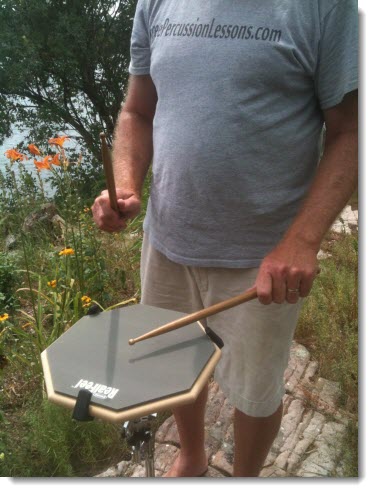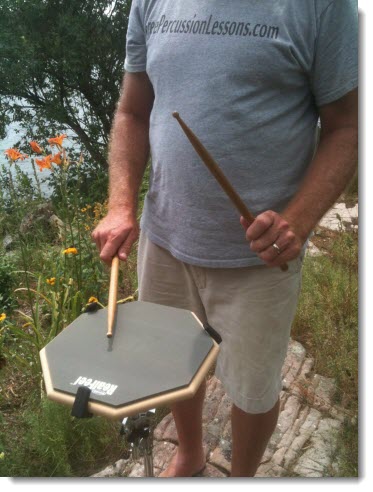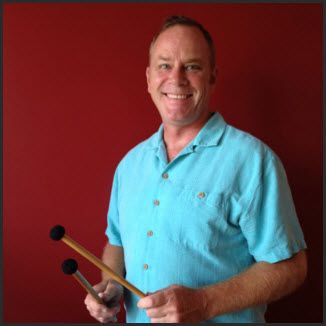Flams can be tricky! But they are very important for every percussionist to learn how to play correctly.
What is a flam?
A flam is a pair of notes played on the snare drum where one note is played ever so slightly ahead of the other note. The first note is a grace note and is played just before the note that is playing the rhythm. The second note is the main note and it’s played on the beat or in rhythm.
Let’s talk about how to play a Flam on the Snare Drum
The Aural Tradition of Learning to Play the FLAM
The very first drummers couldn’t read music so they were taught how to play by being shown what to do and they were taught in an aural tradition. Words were used to help the student remember how to play the rudiments and they were onomatopoeic in nature like Flam, Paradiddle, Ratamacue, etc. and when you say the word it actually sounds like the rudiment itself.
The FLAM is one of those onomatopoeic words and when you say the word you notice that there are two parts of the word. “FL” and “AM”. The way someone naturally says the word flam is with the emphasis on the “AM” and the “FL” sound is less pronounced. To really understand how to play a proper FLAM make sure you say the word and then copy the sound you hear with your sticks on the drum.
How to Play a Flam Stroke
There are two motions that your sticks will make when playing a flam. One of them is the down stroke and the other is the up stroke.
In the first picture my right hand is in the Down Stroke position and the left hand is in the Up Stroke position. The Down Stroke plays the main note. After each flam the sticks switch position as shown in the next picture. Make sure that you play with precise stick positions to ensure that you play the flam accurately. The grace note needs to be very soft and does not interfere with the main note.
Flam Stroke Position 1
Flam Stroke Position 2
Practice the Flam one Stick at a Time
Take the stick in your right hand and hold it about one stick length in height above the drum. That’s where the down stroke starts. When you play the down stroke only allow the stick to rebound off of the drum to the height of 1 inch. That’s where the up stroke starts. The up stroke starts at a point of 1 inch above the drum and “flicks” the drum head as it goes to the down stroke position which is again about one length of the stick in height above the drum.
Play this exercise starting from the down stroke position with one hand then the other separately.
- Down
- Up
- Down
- Up
It’s important that when you play the Down stroke that the stick rebound to a height of only one inch above the drum and when you play the up stroke the stick rebounds to the height of the down stroke position which is about one stick length in height above the drum.
Remember this: The UP stroke is the” FL” and the DOWN stroke is the “AM”
Be a Robot when You Practice the Flam!
Flam strokes need to be practiced as if you were a robot so that the stick heights of the down and up strokes are precise. The reason for the differences in the stick heights for the down and up stroke is because you want the up stroke to be very quiet and the down stroke to be louder.
Now let’s put them together to make the FLAM
With one stick in the down stroke position and the other stick in the up stroke position you will play both sticks at the same time. Because the up stick is closer to the drum it will hit the head slightly ahead of the down stick and create the FLAM. Now your sticks are in the reverse position of your first flam. The stick that played the down stroke is now in the up stroke position and the stick the played the up stroke is now in the down stroke position. This exchange of stick position is very crucial when learning to play clean and good sounding flams.
In the above example the Left stick (L) plays the UP stroke or the “FL” and the Right stick (R) plays the down stroke or “AM”. Once the Left plays the down stroke it stays down and is in position to play the up stroke on the following beat.
Where’s the Beat?
One thing that some students have trouble with when playing flams is that the grace notes or “FL” strokes get too loud and it becomes confusing as to where the beat or rhythm is supposed to be. Always remember that the second note of the flam is where the rhythm is heard.
The “AM” of the flam gets the beat
When you play flams make sure that the FL comes before the AM.
Here it is with just the down stroke:

And here it is as the fully-fledged FLAM:

How to Play Fast Flams
Here’s a trick that will help you play fast flams. Just look at the sticking of the flam.
- It’s LR RL LR RL
- If you take away the first L you get this RRLLRRLL which is just a double stroke roll, right?
Now this trick will only work if you can already play a decent double stroke bounce roll so let’s assume that you can already do this.
If the sticking of alternating flams is RRLLRRLL and the sticking of a double stroke roll is also RRLLRRLL then you should be able to play them at the same speed. It’s all in how you look at it.
What you have to do is to compress the double stroke roll so that you play a flam between the second R and the first L and then between the second L and the first R.
Play Flams on the Snare Drum like Bruce Wayne and Batman
Here’s a silly way of thinking of it but it might help you understand what I’m talking about here. What is the difference between Bruce Wayne and his alter ego, Batman? They are the same person, but Batman is edgy and intense and Bruce Wayne is the nice guy who’s more relaxed. So (stay with me here), a double stroke roll is easy going and relaxed, right? That’s Bruce, but when you compress the same elements that make up the man you end up with an intense version which is Batman.
How to Play Fast Alternating Flams with Batman and Bruce Wayne
Take a look at this video and I’ll make it clearer and easier to understand what I’m talking about, but try to remember that if you can play a double stroke roll you will be able to play alternating flams at the same speed.




How to develop speed
The best method for developing speed that I know is to work slowly and gradually build up your speed. Once you start to feel the least best tense you should back off a little bit, relax and then push the speed a little further being careful not to have any tension.
Speed is only possible if you are relaxed and your technique is flowing and not forced.
When I play very fast flams I’m actually playing a compressed open stroke bounce (diddle) roll. i.e. RRLLRRLL, but I play the diddle roll in a swing pattern so the first R is long and the second R is short acting as the grace note to the next L which is long followed by the second L which is short. It’s important to bounce these strokes just as if you were playing a roll except that it swings in a dotted eighth sixteenth note patter. Once you figure this out you will be able to play flams as fast as you can play a open stroke roll.
Hope this helped. Just remember to practice slow relaxed bounces.